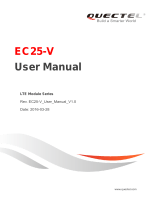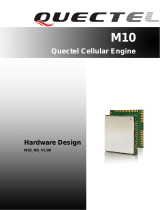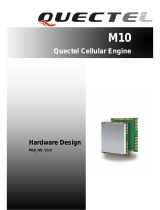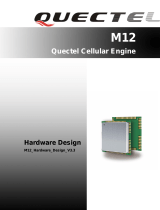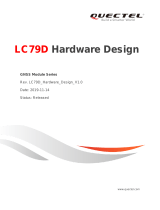Page is loading ...

E
G
LTE
M
Rev.
Date:
Statu
G
91
M
odule
S
EG91_H
a
2019-0
2
s: Relea
s
Ha
S
eries
a
rdware
_
2
-03
s
ed
rd
w
_
Design
_
w
a
r
_
V1.3
r
e
D
D
e
s
s
ig
n
www.que
c
n
c
tel.com

LTE Module Series
EG91 Hardware Design
EG91_Hardware_Design 1 / 93
Our aim is to provide customers with timely and comprehensive service. For any
assistance, please contact our company headquarters:
Quectel Wireless Solutions Co., Ltd.
7
th
Floor, Hongye Building, No.1801 Hongmei Road, Xuhui District, Shanghai 200233, China
Tel: +86 21 5108 6236
Email: [email protected]
Or our local office. For more information, please visit:
http://www.quectel.com/support/sales.htm
For technical support, or to report documentation errors, please visit:
http://www.quectel.com/support/technical.htm
Or email to: [email protected]
GENERAL NOTES
QUECTEL OFFERS THE INFORMATION AS A SERVICE TO ITS CUSTOMERS. THE INFORMATION
PROVIDED IS BASED UPON CUSTOMERS’ REQUIREMENTS. QUECTEL MAKES EVERY EFFORT
TO ENSURE THE QUALITY OF THE INFORMATION IT MAKES AVAILABLE. QUECTEL DOES NOT
MAKE ANY WARRANTY AS TO THE INFORMATION CONTAINED HEREIN, AND DOES NOT ACCEPT
ANY LIABILITY FOR ANY INJURY, LOSS OR DAMAGE OF ANY KIND INCURRED BY USE OF OR
RELIANCE UPON THE INFORMATION. ALLINFORMATION SUPPLIED HEREIN IS SUBJECT TO
CHANGE WITHOUT PRIOR NOTICE.
COPYRIGHT
THE INFORMATION CONTAINED HERE IS PROPRIETARY TECHNICAL INFORMATION OF
QUECTEL WIRELESS SOLUTIONS CO., LTD. TRANSMITTING, REPRODUCTION, DISSEMINATION
AND EDITING OF THIS DOCUMENT AS WELL AS UTILIZATION OF THE CONTENT ARE
FORBIDDEN WITHOUT PERMISSION. OFFENDERS WILL BE HELD LIABLE FOR PAYMENT OF
DAMAGES. ALL RIGHTS ARE RESERVED IN THE EVENT OF A PATENT GRANT OR
REGISTRATION OF A UTILITY MODEL OR DESIGN.
Copyright © Quectel Wireless Solutions Co., Ltd. 2019. All rights reserved.

LTE Module Series
EG91 Hardware Design
EG91_Hardware_Design 2 / 93
About the Document
History
Revision Date Author Description
1.0 2017-03-22
Felix YIN/
Yeoman CHEN/
Jackie WANG
Initial
1.1 2018-01-23
Felix YIN/
Rex WANG
1. Added band B28A.
2. Updated the description of UMTS and GSM
features in Table 2.
3. Updated the functional diagram in Figure 1.
4. Updated module operating frequencies in
Table 21.
5. Updated current consumption in Table 26.
6. Updated RF output power in Table 27.
7. Updated the conducted RF receiving
sensitivity in Table 28.
8. Updated the GPRS multi-slot classes in
Table 33.
9. Added thermal consideration in Chapter 5.8
10. Added a GND pad in each of the four corners
of the module’s footprint in Chapter 6.2.
11. Updated storage information in Chapter 7.1.
12. Added packaging information in Chapter 7.3.
1.2 2018-03-14
Felix YIN/
Rex WANG
1. Added the description of EG91-NA.
2. Updated the functional diagram in Figure 1.
3. Updated pin assignment in Figure 2.
4. Updated GNSS function in Table 1.
5. Updated GNSS Features in Table 2.
6. Updated reference circuit of USB interface
in Figure 21.
7. Added description of GNSS receiver in
Chapter 4.

LTE Module Series
EG91 Hardware Design
EG91_Hardware_Design 3 / 93
8. Updated pin definition of RF antenna in
Table 21.
9. Updated module operating frequencies in
Table 22.
10. Added description of GNSS antenna
interface in Chapter 5.2.
11. Updated antenna requirements in Table 25.
12. Updated RF output power in Table 32.
1.3 2019-02-03
Ward WANG/
Nathan LIU/
Rex WANG
1. Added new variants EG91-NS, EG91-V,
EG91-EC and related contents.
2. Opened pin 24 as ADC0 and added related
contents.
3. Updated functional diagram (Figure 1)
4. Updated pin assignment (Figure 2)
5. Updated GNSS features (Table 2)
6. Added USB_BOOT interface information
(Chapter 3.18)
7. Updated storage information (Chapter 8.1)
8. Updated module operating frequencies
(Table 23)
9. Updatedantenna requirements (Table26)
10. Added current consumption of EG91-NS,
EG91-V and EG91-EC (Table 32, 33 and 34)
11. Added conducted RF receiving sensitivityof
EG91-NS, EG91-V and EG91-EC (Table 39,
40 and 41)

LTE Module Series
EG91 Hardware Design
EG91_Hardware_Design 4 / 93
Contents
About the Document ................................................................................................................................ 2
Contents .................................................................................................................................................... 4
Table Index ............................................................................................................................................... 7
Figure Index .............................................................................................................................................. 9
1 Introduction ..................................................................................................................................... 11
1.1. Safety Information ................................................................................................................. 12
1.2. FCC/ISED Regulatory notices ............................................................................................... 13
2 Product Concept ............................................................................................................................. 16
2.1. General Description .............................................................................................................. 16
2.2. Key Features ......................................................................................................................... 17
2.3. Functional Diagram ............................................................................................................... 19
2.4. Evaluation Board ................................................................................................................... 20
3 Application Interfaces ..................................................................................................................... 21
3.1. General Description .............................................................................................................. 21
3.2. Pin Assignment ..................................................................................................................... 22
3.3. Pin Description ...................................................................................................................... 23
3.4. Operating Modes .................................................................................................................. 30
3.5.
Power Saving ........................................................................................................................ 31
3.5.1. Sleep Mode.................................................................................................................. 31
3.5.1.1. UART Application ............................................................................................... 31
3.5.1.2. USB Application with USB Remote Wakeup Function ....................................... 32
3.5.1.3. USB Application with USB Suspend/Resume and RI Function .......................... 32
3.5.1.4. USB Application without USB Suspend Function ............................................... 33
3.5.2. Airplane Mode .............................................................................................................. 34
3.6. Power Supply ........................................................................................................................ 34
3.6.1. Power Supply Pins ....................................................................................................... 34
3.6.2. Decrease Voltage Drop ................................................................................................ 35
3.6.3. Reference Design for Power Supply ............................................................................ 36
3.6.4. Monitor the Power Supply ............................................................................................ 37
3.7. Power-on/off Scenarios ......................................................................................................... 37
3.7.1. Turn on Module Using the PWRKEY ........................................................................... 37
3.7.2. Turn off Module ............................................................................................................ 39
3.7.2.1. Turn off Module Using the PWRKEY Pin ........................................................... 39
3.7.2.2. Turn off Module Using AT Command ................................................................. 39
3.8. Reset the Module .................................................................................................................. 40
3.9. (U)SIM Interfaces .................................................................................................................. 41
3.10. USB Interface ........................................................................................................................ 44
3.11. UART Interfaces ................................................................................................................... 46

LTE Module Series
EG91 Hardware Design
EG91_Hardware_Design 5 / 93
3.12. PCM and I2C Interfaces ........................................................................................................ 48
3.13. SPI Interface ......................................................................................................................... 51
3.14. Network Status Indication ..................................................................................................... 51
3.15. STATUS ................................................................................................................................ 52
3.16. ADC Interface ....................................................................................................................... 53
3.17. Behaviors of RI ..................................................................................................................... 54
3.18. USB_BOOT Interface............................................................................................................ 55
4 GNSS Receiver ................................................................................................................................ 57
4.1. General Description .............................................................................................................. 57
4.2. GNSS Performance .............................................................................................................. 57
4.3. Layout Guidelines ................................................................................................................. 58
5 Antenna Interfaces .......................................................................................................................... 59
5.1. Main/Rx-diversityAntenna Interfaces..................................................................................... 59
5.1.1. Pin Definition ................................................................................................................ 59
5.1.2. Operating Frequency ................................................................................................... 59
5.1.3. Reference Design of RF Antenna Interface ................................................................. 60
5.1.4. Reference Design of RF Layout ................................................................................... 61
5.2. GNSS Antenna Interface ....................................................................................................... 63
5.3. Antenna Installation .............................................................................................................. 64
5.3.1. Antenna Requirement .................................................................................................. 64
5.3.2. Recommended RF Connector for Antenna Installation ................................................ 65
6 Electrical, Reliability and RadioCharacteristics ........................................................................... 67
6.1. Absolute Maximum Ratings .................................................................................................. 67
6.2. Power Supply Ratings ........................................................................................................... 67
6.3. Operation and Storage Temperatures .................................................................................. 68
6.4. Current Consumption ............................................................................................................ 69
6.5. RF Output Power .................................................................................................................. 76
6.6. RF Receiving Sensitivity ....................................................................................................... 77
6.7. Electrostatic Discharge ......................................................................................................... 79
6.8. Thermal Consideration .......................................................................................................... 79
7 Mechanical Dimensions.................................................................................................................. 82
7.1. Mechanical Dimensions of the Module.................................................................................. 82
7.2. Recommended Footprint ....................................................................................................... 84
7.3.
Design Effect Drawings of the Module .................................................................................. 85
8 Storage, Manufacturing and Packaging ........................................................................................ 86
8.1. Storage ................................................................................................................................. 86
8.2. Manufacturing and Soldering ................................................................................................ 87
8.3. Packaging ............................................................................................................................. 88
9 Appendix A References .................................................................................................................. 90
10 Appendix B GPRS Coding Schemes ............................................................................................. 94

LTE Module Series
EG91 Hardware Design
EG91_Hardware_Design 6 / 93
11 Appendix C GPRS Multi-slot Classes ............................................................................................ 95
12 Appendix D EDGE Modulation and Coding Schemes .................................................................. 97

LTE Module Series
EG91 Hardware Design
EG91_Hardware_Design 7 / 93
Table Index
TABLE 1: FREQUENCY BANDS OF EG91 SERIES MODULE ....................................................................... 16
TABLE 2: KEY FEATURES OF EG91 MODULE ............................................................................................... 17
TABLE 3: IO PARAMETERS DEFINITION ........................................................................................................ 23
TABLE 4: PIN DESCRIPTION ........................................................................................................................... 23
TABLE 5: OVERVIEW OF OPERATING MODES ............................................................................................. 30
TABLE 6: PIN DEFINITION OF VBAT AND GND ............................................................................................. 35
TABLE 7: PIN DEFINITION OF PWRKEY ........................................................................................................ 37
TABLE 8: PIN DEFINITION OF RESET_N ....................................................................................................... 40
TABLE 9: PIN DEFINITION OF (U)SIM INTERFACES ..................................................................................... 42
TABLE 10: PIN DEFINITION OF USB INTERFACE ......................................................................................... 44
TABLE 11: PIN DEFINITION OF MAIN UART INTERFACES ........................................................................... 46
TABLE 12: PIN DEFINITION OF DEBUG UART INTERFACE ......................................................................... 46
TABLE 13: LOGIC LEVELS OF DIGITAL I/O .................................................................................................... 47
TABLE 14: PIN DEFINITION OF PCM AND I2C INTERFACES ....................................................................... 50
TABLE 15: PIN DEFINITION OF SPI INTERFACE ........................................................................................... 51
TABLE 16: PIN DEFINITION OF NETWORK STATUS INDICATOR ................................................................ 52
TABLE 17: WORKING STATE OF NETWORK STATUS INDICATOR .............................................................. 52
TABLE 18: PIN DEFINITION OF STATUS ........................................................................................................ 53
TABLE 19: PIN DEFINITION OF ADC INTERFACE ......................................................................................... 53
TABLE 20: CHARACTERISTICS OF ADC INTERFACE ................................................................................... 54
TABLE 21: DEFAULT BEHAVIORS OF RI ........................................................................................................ 54
TABLE 22: PIN DEFINITION OF USB_BOOT INTERFACE ............................................................................. 55
TABLE 23: GNSS PERFORMANCE ................................................................................................................. 57
TABLE 24: PIN DEFINITION OF RF ANTENNA ............................................................................................... 59
TABLE 25: MODULE OPERATING FREQUENCIES ........................................................................................ 59
TABLE 26: PIN DEFINITION OF GNSS ANTENNA INTERFACE ..................................................................... 63
TABLE 27: GNSS FREQUENCY ....................................................................................................................... 63
TABLE 28: ANTENNA REQUIREMENTS .......................................................................................................... 64
TABLE 29: ABSOLUTE MAXIMUM RATINGS .................................................................................................. 67
TABLE 30: POWER SUPPLY RATINGS ........................................................................................................... 67
TABLE 31: OPERATION AND STORAGE TEMPERATURES .......................................................................... 68
TABLE 32: EG91-E CURRENT CONSUMPTION ............................................................................................. 69
TABLE 33: EG91-NA CURRENT CONSUMPTION ........................................................................................... 71
TABLE 34: EG91-NS CURRENT CONSUMPTION .......................................................................................... 72
TABLE 35: EG91-V CURRENT CONSUMPTION ............................................................................................. 73
TABLE 36: EG91-EC CURRENT CONSUMPTION .......................................................................................... 74
TABLE 37: GNSS CURRENT CONSUMPTION OF EG91 ............................................................................... 76
TABLE 38: RF OUTPUT POWER ..................................................................................................................... 76
TABLE 39: EG91-E CONDUCTED RF RECEIVING SENSITIVITY .................................................................. 77
TABLE 40: EG91-NA CONDUCTED RF RECEIVING SENSITIVITY ............................................................... 77
TABLE 41: EG91-NS CONDUCTED RF RECEIVING SENSITIVITY ............................................................... 78
TABLE 42: EG91-V CONDUCTED RF RECEIVING SENSITIVITY .................................................................. 78

LTE Module Series
EG91 Hardware Design
EG91_Hardware_Design 8 / 93
TABLE 43: EG91-EC CONDUCTED RF RECEIVING SENSITIVITY ............................................................... 78
TABLE 44: ELECTROSTATIC DISCHARGE CHARACTERISTICS ................................................................. 79
TABLE 45: RECOMMENDED THERMAL PROFILE PARAMETERS ............................................................... 87
TABLE 46: RELATED DOCUMENTS ................................................................................................................ 90
TABLE 47: TERMS AND ABBREVIATIONS ...................................................................................................... 90
TABLE 48: DESCRIPTION OF DIFFERENT CODING SCHEMES .................................................................. 94
TABLE 49: GPRS MULTI-SLOT CLASSES ...................................................................................................... 95
TABLE 50: EDGE MODULATION AND CODING SCHEMES ........................................................................... 97

LTE Module Series
EG91 Hardware Design
EG91_Hardware_Design 9 / 93
Figure Index
FIGURE 1: FUNCTIONAL DIAGRAM ............................................................................................................... 20
FIGURE 2: PIN ASSIGNMENT (TOP VIEW) .................................................................................................... 22
FIGURE 3: SLEEP MODE APPLICATION VIA UART ....................................................................................... 31
FIGURE 4: SLEEP MODE APPLICATION WITH USB REMOTE WAKEUP .................................................... 32
FIGURE 5: SLEEP MODE APPLICATION WITH RI ......................................................................................... 33
FIGURE 6: SLEEP MODE APPLICATION WITHOUT SUSPEND FUNCTION ................................................ 34
FIGURE 7: POWER SUPPLY LIMITS DURING BURST TRANSMISSION ...................................................... 35
FIGURE 8: STAR STRUCTURE OF THE POWER SUPPLY ............................................................................ 36
FIGURE 9: REFERENCE CIRCUIT OF POWER SUPPLY .............................................................................. 36
FIGURE 10: TURN ON THE MODULE USING DRIVING CIRCUIT ................................................................. 37
FIGURE 11: TURN ON THE MODULE USING BUTTON ................................................................................. 38
FIGURE 12: POWER-ON SCENARIO .............................................................................................................. 38
FIGURE 13: POWER-OFF SCENARIO ............................................................................................................ 39
FIGURE 14: REFERENCE CIRCUIT OF RESET_N BY USING DRIVING CIRCUIT ...................................... 40
FIGURE 15: REFERENCE CIRCUIT OF RESET_N BY USING BUTTON ...................................................... 41
FIGURE 16: RESET SCENARIO ...................................................................................................................... 41
FIGURE 17: REFERENCE CIRCUIT OF (U)SIM INTERFACE WITH AN 8-PIN (U)SIM CARD CONNECTOR
................................................................................................................................................................... 43
FIGURE 18: REFERENCE CIRCUIT OF (U)SIM INTERFACE WITH A 6-PIN (U)SIM CARD CONNECTOR . 43
FIGURE 19: REFERENCE CIRCUIT OF USB INTERFACE ............................................................................ 45
FIGURE 20: REFERENCE CIRCUIT WITH TRANSLATOR CHIP ................................................................... 47
FIGURE 21: REFERENCE CIRCUIT WITH TRANSISTOR CIRCUIT .............................................................. 48
FIGURE 22: PRIMARY MODE TIMING ............................................................................................................ 49
FIGURE 23: AUXILIARY MODE TIMING .......................................................................................................... 49
FIGURE 24: REFERENCE CIRCUIT OF PCM APPLICATION WITH AUDIO CODEC .................................... 50
FIGURE 25: REFERENCE CIRCUIT OF SPI INTERFACE WITH PERIPHERALS ......................................... 51
FIGURE 26: REFERENCE CIRCUIT OF NETWORK STATUS INDICATOR ................................................... 52
FIGURE 27: REFERENCE CIRCUIT OF STATUS ........................................................................................... 53
FIGURE 28: REFERENCE CIRCUIT OF USB_BOOT INTERFACE ................................................................ 55
FIGURE 29: TIMING SEQUENCE FOR ENTERING INTO EMERGENCY DOWNLOAD MODE .................... 56
FIGURE 30: REFERENCE CIRCUIT OF RF ANTENNA INTERFACE ............................................................. 61
FIGURE 31: MICROSTRIP LINE DESIGN ON A 2-LAYER PCB ...................................................................... 62
FIGURE 32: COPLANAR WAVEGUIDE DESIGN ON A 2-LAYER PCB ........................................................... 62
FIGURE 33: COPLANAR WAVEGUIDE DESIGN ON A 4-LAYER PCB (LAYER 3 AS REFERENCE GROUND)
................................................................................................................................................................... 62
FIGURE 34: COPLANAR WAVEGUIDE DESIGN ON A 4-LAYER PCB (LAYER 4 AS REFERENCE GROUND)
................................................................................................................................................................... 62
FIGURE 35: REFERENCE CIRCUIT OF GNSS ANTENNA ............................................................................. 64
FIGURE 36: DIMENSIONS OF THE U.FL-R-SMT CONNECTOR (UNIT: MM) ................................................ 65
FIGURE 37: MECHANICALS OF U.FL-LP CONNECTORS ............................................................................. 66
FIGURE 38: SPACE FACTOR OF MATED CONNECTOR (UNIT: MM) ........................................................... 66

LTE Module Series
EG91 Hardware Design
EG91_Hardware_Design 10 / 93
FIGURE 39: REFERENCED HEATSINK DESIGN (HEATSINK AT THE TOP OF THE MODULE) .................. 80
FIGURE 40: REFERENCED HEATSINK DESIGN (HEATSINK AT THE BACKSIDE OF CUSTOMERS’ PCB)
................................................................................................................................................................... 81
FIGURE 41: MODULE TOP AND SIDE DIMENSIONS ..................................................................................... 82
FIGURE 42: MODULE BOTTOM DIMENSIONS (TOP VIEW) ......................................................................... 83
FIGURE 43: RECOMMENDED FOOTPRINT (TOP VIEW) .............................................................................. 84
FIGURE 44: TOP VIEW OF THE MODULE ...................................................................................................... 85
FIGURE 45: BOTTOM VIEW OF THE MODULE .............................................................................................. 85
FIGURE 46: REFLOW SOLDERING THERMAL PROFILE .............................................................................. 87
FIGURE 47: TAPE DIMENSIONS ..................................................................................................................... 88
FIGURE 48: REEL DIMENSIONS ..................................................................................................................... 89
FIGURE 49: TAPE AND REEL DIRECTIONS ................................................................................................... 89

LTE Module Series
EG91 Hardware Design
EG91_Hardware_Design 11 / 93
1 Introduction
This document defines the EG91module and describes its air interface and hardware interface which are
connected with customers’ applications.
This document can help customers quickly understand module interface specifications, electrical
andmechanical details, as well as other related information of EG91 module. Associated with application
note and user guide, customers can use EG91 module to design and set up mobile applications easily.

LTE Module Series
EG91 Hardware Design
EG91_Hardware_Design 12 / 93
1.1. Safety Information
The following safety precautions must be observed during all phases of operation, such as usage, service
or repair of any cellular terminal or mobile incorporating EG91module. Manufacturers of the cellular terminal
should send the following safety information to users and operating personnel, and incorporate these
guidelines into all manuals supplied with the product. If not so, Quectel assumes no liability for customers’
failure to comply with these precautions.
Full attention must be given to driving at all times in order to reduce the risk of an
accident. Using a mobile while driving (even with a handsfree kit) causes
distraction and can lead to an accident. Please comply with laws and regulations
restricting the use of wireless devices while driving.
Switch off the cellular terminal or mobile before boarding an aircraft. The operation
of wireless appliances in an aircraft is forbidden to prevent interference with
communication systems. If the device offers an Airplane Mode, then it should be
enabled prior to boarding an aircraft. Please consult the airline staff for more
restrictions on the use of wireless devices on boarding the aircraft.
Wireless devices may cause interference on sensitive medical equipment, so
please be aware of the restrictions on the use of wireless devices when in
hospitals,clinics or other healthcare facilities.
Cellular terminals or mobiles operating over radio signals and cellular network
cannot be guaranteed to connect in all possible conditions (for example, with
unpaid bills or with an invalid (U)SIM card). When emergent help is needed in such
conditions, please remember using emergency call. In order to make or receive a
call, the cellular terminal or mobile must be switched on in a service area with
adequate cellular signal strength.
The cellular terminal or mobile contains a transmitter and receiver. When it is ON, it
receives and transmits radio frequency signals. RF interference can occur if it is
used close to TV set, radio, computer or other electric equipment.
In locations with potentially explosive atmospheres, obey all posted signs to turn
off wireless devices such as your phone or other cellular terminals. Areas with
potentially explosive atmospheres include fuelling areas, below decks on boats,
fuel or chemical transfer or storage facilities, areas where the air contains
chemicals or particles such as grain, dust or metal powders, etc.

LTE Module Series
EG91 Hardware Design
EG91_Hardware_Design 13 / 93
1.2. FCC/ISED Regulatory notices
Modification statement
Quectel has not approved any changes or modifications to this device by the user. Any changes or modifications could void the user’s
authority to operate the equipment.
Quectel n’approuve aucune modification apportée à l’appareil par l’utilisateur, quelle qu’en soit la nature. Tout changement ou
modification peuvent annuler le droit d’utilisation de l’appareil par l’utilisateur.
Interference statement
This device complies with Part 15 of the FCC Rules and Industry Canada licence-exempt RSS standard(s). Operation is subject to the
following two conditions: (1) this device may not cause interference, and (2) this device must accept any interference, including
interference that may cause undesired operation of the device.
Le présent appareil est conforme aux CNR d'Industrie Canada applicables aux appareils radio exempts de licence. L'exploitation est
autorisée aux deux conditions suivantes : (1) l'appareil ne doit pas produire de brouillage, et (2) l'utilisateur de l'appareil doit
accepter tout brouillage radioélectrique subi, même si le brouillage est susceptible d'en compromettre le fonctionnement.
RF exposure
This equipment complies with FCC and ISED radiation exposure limits set forth for an uncontrolled environment. The
antenna should be installed and operated with minimum distance of 20 cm between the radiator and your body. Antenna
gain must be below:
Antenna Gain
❒ WCDAM II:≤9.000dBi
❒ WCDAM V:≤6.000dBi
❒ WCDAM VIII:≤10.416dBi
❒ LTE Band2:≤8.500dBi
❒ LTE Band4:≤5.500dBi
❒ LTE Band5:≤9.916dBi
❒ LTE Band12:≤9.234dBi
❒ LTE Band13:≤9.673dBi
❒ L TE Band25:≤8.500dBi
❒ L TE Band25:≤9.837dBi
This transmitter must not be co-located or operating in conjunction with any other antenna or transmitter.
The host end product must include a user manual that clearly defines operating requirements and conditions that must be
observed to ensure compliance with current FCC RF exposure guidelines.
For portable devices, in addition to above, a separate approval is required to satisfy the SAR requirements of FCC Part
2.1093.
If the device is used for other equipment that separate approval is required for all other operating configurations, including
portable configurations with respect to 2.1093 and different antenna configurations.
Cet appareil est conforme aux limites d'exposition aux rayonnements de l’ISED pour un environnement non contrôlé.
L'antenne doit être installé de façon à garder une distance minimale de 20 centimètres entre la source de rayonnements et
votre corps. Gain de l'antenne doit être ci-dessous:
Gain de l‘antenne

LTE Module Series
EG91 Hardware Design
EG91_Hardware_Design 14 / 93
❒ WCDAM II:≤9.00dBi
❒ WCDAM V:≤6.00dBi
❒ WCDAM VIII:≤7.15dBi
❒ LTE Band2:≤8.50dBi
❒ LTE Band4:≤5.50dBi
❒ LTE Band5:≤6.64dBi
❒ LTE Band12:≤6.15dBi
❒ LTE Band13:≤6.44dBi
❒ L TE Band25:≤8.50dBi
❒ L TE Band25:≤6.63dBi
L'émetteur ne doit pas être colocalisé ni fonctionner conjointement avec à autre antenne ou autre émetteur.
FCC Class B digital device notice
This equipment has been tested and found to comply with the limits for a Class B digital device, pursuant to part 15 of the FCC Rules.
These limits are designed to provide reasonable protection against harmful interference in a residential installation. This equipment
generates, uses and can radiate radio frequency energy and, if not installed and used in accordance with the instructions, may cause
harmful interference to radio communications. However, there is no guarantee that interference will not occur in a particular
installation. If this equipment does cause harmful interference to radio or television reception, which can be determined by turning the
equipment off and on, the user is encouraged to try to correct the interference by one or more of the following measures:
• Reorient or relocate the receiving antenna.
• Increase the separation between the equipment and receiver.
• Connect the equipment into an outlet on a circuit different from that to which the receiver is connected.
• Consult the dealer or an experienced radio/TV technician for help.
Labelling Requirements for the Host device
The host device shall be properly labelled to identify the modules within the host device. The certification label of the
module shall be clearly visible at all times when installed in the host device, otherwise the host device must be labelled to
display the FCC ID and ISED of the module, preceded by the words "Contains transmitter module", or the word "Contains",
or similar wording expressing the same meaning, as follows:
Contains FCC ID:XMR201903EG91NS
Contains IC: 10224A-20193EG91NS
The host OEM user manual must also contain clear instructions on how end users can find and/or access the module and
the FCC ID and ISED.
L'appareil hôte doit être étiqueté comme il faut pour permettre l'identification des modules qui s'y trouvent. L'étiquette de
certification du module donné doit être posée sur l'appareil hôte à un endroit bien en vue en tout temps. En l'absence
d'étiquette, l'appareil hôte doit porter une étiquette donnant le FCC ID et l’ISED du module, précédé des mots « Contient un
module d'émission », du mot « Contient » ou d'une formulation similaire exprimant le même sens, comme suit :
Contient FCC ID:XMR201903EG91NS
Contient IC: 10224A-20193EG91NS
Le manuel d'utilisation OEM de l'hôte doit également contenir des instructions claires sur la manière dont les utilisateurs
finaux peuvent trouver et / ou accéder au module et à l'ID FCC et l’ISED.

LTE Module Series
EG91 Hardware Design
EG91_Hardware_Design 15 / 93
CAN ICES-3 (B) / NMB-3 (B)
This Class B digital apparatus complies with Canadian ICES-003.
Cet appareil numérique de classe B est conforme à la norme canadienne ICES-003.
Installation Guidance
The final host / module combination may also need to be evaluated against the FCC Part 15B criteria for unintentional
radiators in order to be properly authorized for operation as a Part 15 digital device.
The user’s manual or instruction manual for an intentional or unintentional radiator shall caution the user that changes or
modifications not expressly approved by the party responsible for compliance could void the user's authority to operate the
equipment. In cases where the manual is provided only in a form other than paper, such as on a computer disk or over the
Internet, the information required by this section may be included in the manual in that alternative form, provided the user
can reasonably be expected to have the capability to access information in that form.
To ensure compliance with all non-transmitter functions the host manufacturer is responsible for ensuring compliance with
the module(s) installed and fully operational. For example, if a host was previously authorized as an unintentional radiator
under the Declaration of Conformity procedure without a transmitter certified module and a module is added, the host
manufacturer is responsible for ensuring that the after the module is installed and operational the host continues to be
compliant with the Part 15B unintentional radiator requirements.

LTE Module Series
EG91 Hardware Design
EG91_Hardware_Design 16 / 93
2 Product Concept
2.1. General Description
EG91module is an embedded 4G wireless communication module with receive diversity. It
supportsLTE-FDD/WCDMA/GSM wireless communication, andprovides data connectivity on
LTE-FDD,DC-HSDPA, HSPA+, HSDPA, HSUPA, WCDMA,EDGE andGPRSnetworks. It can also provide
voice functionality
1)
to meet customers’ specific application demands. The following table shows the
frequency bands of EG91series module.
Table 1: Frequency Bands of EG91Series Module
1.
1)
EG91contains Telematicsversion and Data-only version. Telematics version supports voice and
datafunctions, while Data-only version only supports data function.
2.
2)
GNSS function is optional.
Module
LTE Bands
(with Rx-diversity)
WCDMA
(with Rx-diversity)
GSM GNSS
2)
EG91-E
FDD:
B1/B3/B7/B8/B20/B28A
B1/B8 900/1800MHz Not supported
EG91-NA FDD: B2/B4/B5/B12/B13 B2/B4/B5 Not supported
GPS, GLONASS,
BeiDou/Compass,G
alileo, QZSS
EG91-NS
FDD:
B2/B4/B5/B12/B13/B25/
B26
B2/B4/B5 Not supported
GPS, GLONASS,
BeiDou/Compass,
Galileo, QZSS
EG91-V FDD: B4/B13 Not supported Not supported
GPS, GLONASS,
BeiDou/Compass,
Galileo, QZSS
EG91-EC
FDD:
B1/B3/B7/B8/B20/B28
B1/B8 900/1800MHz
GPS, GLONASS,
BeiDou/Compass,
Galileo, QZSS
NOTES

LTE Module Series
EG91 Hardware Design
EG91_Hardware_Design 17 / 93
With a compact profile of 29.0mm ×25.0mm ×2.3mm, EG91 can meet almost all requirements for M2M
applications such as automotive, smart metering, tracking system, security, router, wireless POS, mobile
computing device, PDA phone, tablet PC, etc.
EG91 is an SMD type module which can be embedded into applications through its 106 LGA pads.
EG91 is integrated with internet service protocols like TCP, UDP and PPP. Extended AT commands have
been developed for customers to use these internet service protocols easily.
2.2. Key Features
The following table describes the detailed features of EG91 module.
Table 2: Key Features of EG91 Module
Feature Details
Power Supply
Supply voltage: 3.3V~4.3V
Typical supply voltage: 3.8V
Transmitting Power
Class 4 (33dBm±2dB) for EGSM900
Class 1 (30dBm±2dB) for DCS1800
Class E2 (27dBm±3dB) for EGSM900 8-PSK
Class E2 (26dBm±3dB) for DCS1800 8-PSK
Class 3 (24dBm+1/-3dB) for WCDMA bands
Class 3 (23dBm±2dB) for LTE-FDD bands
LTE Features
Support up to non-CA Cat 1 FDD
Support 1.4MHz~20MHz RF bandwidth
Support MIMO in DL direction
LTE-FDD: Max 10Mbps (DL), Max 5Mbps (UL)
UMTS Features
Support 3GPP R8 DC-HSDPA, HSPA+, HSDPA, HSUPA and WCDMA
Support QPSK, 16-QAM and 64-QAM modulation
DC-HSDPA: Max 42Mbps (DL)
HSUPA: Max 5.76Mbps (UL)
WCDMA: Max 384Kbps (DL), Max 384Kbps (UL)
GSMFeatures
R99:
CSD: 9.6kbps
GPRS:
Support GPRS multi-slot class 33(33 by default)
Coding scheme: CS-1, CS-2, CS-3 and CS-4
Max 107Kbps (DL), Max 85.6Kbps (UL)
EDGE:

LTE Module Series
EG91 Hardware Design
EG91_Hardware_Design 18 / 93
Support EDGE multi-slot class 33(33 by default)
Support GMSK and 8-PSK for different MCS (Modulation and Coding
Scheme)
Downlink coding schemes: CS 1-4 and MCS 1-9
Uplink coding schemes: CS 1-4 and MCS 1-9
Max 296Kbps (DL)/Max 236.8Kbps (UL)
Internet Protocol Features
SupportTCP/UDP/PPP/FTP/HTTP/NTP/PING/QMI/NITZ/CMUX*/HTTPS*/
SMTP*/MMS*/FTPS*/SMTPS*/SSL*/FILE* protocols
Support PAP (Password Authentication Protocol) and CHAP (Challenge
Handshake Authentication Protocol) protocols which are usually used for
PPP connections
SMS
Text and PDU modes
Point-to-point MO and MT
SMS cell broadcast
SMS storage: ME by default
(U)SIMInterfaces Support 1.8V and 3.0V (U)SIM cards
Audio Features
Support one digital audio interface: PCM interface
GSM: HR/FR/EFR/AMR/AMR-WB
WCDMA: AMR/AMR-WB
LTE: AMR/AMR-WB
Support echo cancellation and noise suppression
PCM Interface
Used for audio function with external codec
Support 16-bit linear data format
Support long frame synchronization and short frame synchronization
Support master and slave mode, but must be the master in long frame
synchronization
USB Interface
Compliant with USB 2.0 specification (slave only);the data transfer rate can
reach up to 480Mbps
Used for AT command communication, data transmission,GNSS NMEA
sentences output, software debugging, firmware upgrade and voice over
USB*
Support USB serial drivers for: Windows 7/8/8.1/10, Windows CE
5.0/6.0/7.0*, Linux 2.6/3.x/4.1~4.14, Android 4.x/5.x/6.x/7.x/8.x, etc.
UART Interface
Main UART:
Used for AT command communication and data transmission
Baud rates reach up to 921600bps, 115200bps by default
Support RTS and CTS hardware flow control
Debug UART:
Used for Linux console and log output
115200bps baud rate
Rx-diversity Support LTE/WCDMA Rx-diversity
GNSS Features Gen8C Lite of Qualcomm

LTE Module Series
EG91 Hardware Design
EG91_Hardware_Design 19 / 93
Protocol: NMEA 0183
AT Commands
Compliant with 3GPP TS 27.007, 27.005 and Quectel enhanced AT
commands
Network Indication NETLIGHTpin for network activitystatusindication
Antenna Interfaces
Including main antenna interface (ANT_MAIN), Rx-diversity antenna
(ANT_DIV) interface and GNSS antenna interface(ANT_GNSS)
1)
Physical Characteristics
Size: (29.0±0.15)mm × (25.0±0.15)mm × (2.3±0.2)mm
Package: LGA
Weight: approx. 3.8g
Temperature Range
Operation temperature range: -35°C ~ +75°C
2)
Extended temperature range: -40°C ~ +85°C
3)
Storage temperature range: -40°C ~ +90°C
Firmware Upgrade USB interface orDFOTA*
RoHS All hardware components are fully compliant with EU RoHS directive
1.
1)
GNSS antenna interface is only supported on EG91-NA/-NS/-V/-EC.
2.
2)
Within operationtemperature range, the module is 3GPP compliant.
3.
3)
Within extended temperature range, the module remains the ability to establish and maintain a
voice, SMS, data transmission, emergency call, etc. There is no unrecoverable malfunction. There
are also no effects on radio spectrum and no harm to radio network. Only one or more parameters
like P
out
might reduce in their value and exceed the specified tolerances. When the temperature
returns to normal operationtemperature levels, the module will meet 3GPP specificationsagain.
4. “*” means under development.
2.3. Functional Diagram
The following figure shows a block diagram of EG91 and illustrates the major functional parts.
Power management
Baseband
DDR+NAND flash
Radio frequency
Peripheral interfaces
NOTES
/
